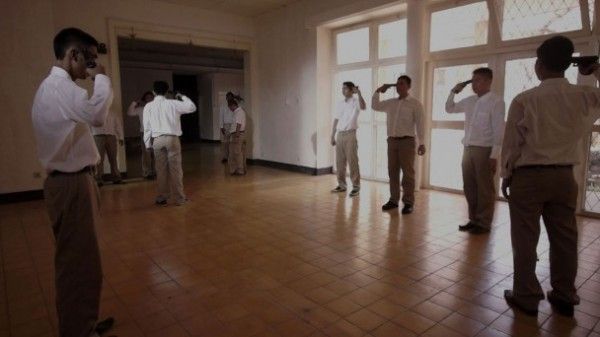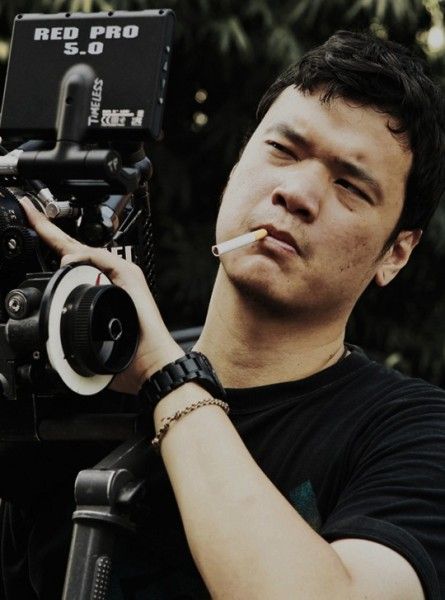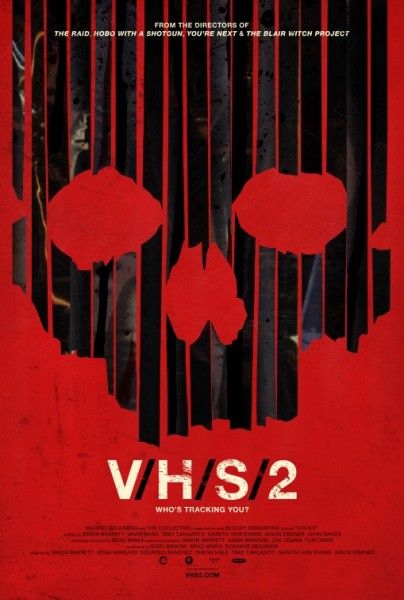When it comes to Gareth Evans and Timo Tjahjanto I’m a new, but passionate fan. Last year Evans gave us The Raid: Redemption, a feature-length action masterpiece of balls-out violence and ass-kicking badassery. Earlier this year Tjahjanto contributed the standout segment “L for Libido” to the horror anthology The ABC’s of Death, and managed to create horror landscape so perverse and captivating that when the short film’s few minutes were up I was, at the same time, glad it was over and dying to see more. For V/H/S/2 Evans and Tjahjanto teamed up to give us “Safe Haven”, an epic slaughter grounded in a fascinating mythology that combines Evans’s visceral cinematic style with Tjanhanjto’s eye for twisted terrors. For me, David Bruckner’s “Amateur Night” was the prize winner of the first V/H/S, and this time around it’s “Safe Haven” that stands as the absolute apex of the film’s achievements.
Last week I jumped on the phone for an interview with Evans and Tjahjanto. We discussed their first time working as co-directors, the difficulty of staying within the time constraints, playing with the found footage format, the possibility of turning “Safe Haven” in to a feature film, Tjahjanto’s upcoming film The Night Comes for Us, and more. I also got a quick update on The Raid: Berandal. V/H/S/2 also features segments by Jason Eisener, Adam Wingard, Simon Barrett, Eduardo Sanchez and Gregg Hale. Check out the full interview after the Jump. Please be aware that there are some spoilers.
Collider: What was it like for you guys working together as a directorial team? I imagine that might be kind of a challenge if you’re used to working on your own.
TIMO TJAHJANTO: With me, because I come from a horror background and I knew the moment I wrote the basic synopsis for it that I wasn’t going to do it unless I had somebody next to me who has the knowhow of who to do this kinetic filmmaking. Obviously Gareth and I have been friends for a while, and while I can obviously lead on all the gross and gory kind of disturbing points, the energy is all about Gareth’s being there in the film. Honestly, I learned so much on this film.f It’s ridiculous how Gareth kind of knows how to handle the camera and make it like a living, breathing character.
GARETH EVANS: So it’s quite clear that Timo loves me [laughs]. No, likewise, I think it was kind of a learning experience for both of us in a way, because I come from an action background mostly and I was a fan of horror films, but never really tried to do something like that myself. So we got contacted separately at first for doing a segment for V/H/S/2 and then I called Timo and said, “Look I got asked to do this thing and I’m not really sure if I’m confident to do it by myself.” We were both looking for something to collaborate on and it just fell into place that we would collaborate on this. It was like this great creative energy going into the film because we both share very similar taste in movies, we both kind of come to it from the same appreciation of this type of cinema from all over the world. We’ve been friends for a long time, we’ve watched the same movies together, so the energy on set, not just in pre-production when we writing it, but also on the set when we would kind of improvise ideas. when we were shooting neither of us was the stopping point on an idea, we could kind of just workshop it and figure it out, try to bounce ideas off each other, and just keep snowballing our concept further and further and further as we would go along.
TJAHJANTO: Until we realized the budget.
EVANS: Yeah, until we realized we were running out of budget and running out of time. I think some of the departments were starting to get frustrated with us because we would say, “Okay, we got this normal chase scene…” I felt sorry for our assistant director Gita, because she’d arranged for a quick two hour shoot just to shoot our lead actor running out of that building. There was supposed to be like no obstacles in the original version of that scene, and then suddenly we kind of were like, “This is fucking bullshit. We need to put lots of obstacles in the way. We need a reanimated corpse of his fucking best friend, we need a classroom full of zombie kids, we also need a guy having his head ripped off and thrown against the window. We need to see a fucking Minotaur fucking demon smashing somebody against the wall. We need to see an old couple fucking in the bedroom.” All these things, and suddenly – this was about two or three hours before we were about to shoot, and makeup department they’re having to fix everyone, our casting guy is now having to convince two of the extras that were only brought in for a small moment to strip down and start fucking, and we’re, meanwhile, just kind of high-fiving each other like douche bags saying, “Yeah lets fucking do this, let’s go crazy, let’s give it more.”
TJAHJANTO: Our ignorance to our crews suffering was good.
EVANS: [Laughs] Yeah.
So when it comes to this low-budget, found footage subgenre there’s the single camera POV set up, and then there’s this next level shit you guys pulled off with a bunch of camera setups, clever editing, all that, I’m curious about your planning process on that. How did you set all that up, and decide where the cameras would be and what they would be used for?
EVANS: Half of it was to be able to maintain a certain cinematic approach to how we could edit and sort of help sort out any pacing issues, because we were a little concerned because our script came in a little long. It was about 26, 27 pages and we were supposed to bring something in about 20 minutes, between 15-20 minutes.
TJAHJANTO: [Laughs]
EVANS: [Laughs] Yeah, so we were blindly fooling ourselves into thinking we could bring it in in 20 minutes. so I though well maybe if we can use the spy cameras on each of the characters, which meant that we’d have a cut away so wherever we needed to, we could kind of trim things down so weren’t locked into one perspective. and then using the production cameras as well helped with that and then on top of that we added the CTTV cameras. It’s something of a cheat in terms of what people usually expect from found footages, but we didn’t really approach it as the view of it being found footage, more of the view of it being POV, and once we kind of decided that it opened it up so we could be much more flexible with how we structured the film and how we paced it as well.
I’m curious about the effects, because there was a lot of gore and it all look really good. How much of that was practical and how much was CG?
EVANS: The exploding guy is practical. [Laughs] We just strapped grenades to him and hoped for the best. When we made the film, Timo had worked with [Kumalasari Tanara] the makeup artist on his movie Macabre and I always wanted to work with her before. I think we both were approaching her at the same time, for Timo’s first movie and my first, we both kind of approached her and Timo won out in the end through sheer loyalty that I had to him as a friend. [Laughs] So when it came to safe haven it was finally a chance for us both to work with her. I’ve been very reliant on digital effects in my last two movies purely because I wasn’t really satisfied that much with the practical effects we’d done, and so the digital aspect was always to kind of help fix problems on the way. But when it came to “Safe Haven” then the practical effects looked so good that the only things we really did digital effects were the things that we couldn’t just to practically. It was a combination really of great work by the makeup artist and then Andi [Novianto], our online editor who is basically the best editor we have here for doing a little digital blood, digital gore, and stuff like that. It was a combination, 50/50 kind of.
A lot of the response to “Safe Haven” has been that it would make for a really good feature length film on its own, is that something that you guys might ever be interested in?
TJAHJANTO: The thought actually crosses our minds, or at least mine.
EVANS: Yeah, we thought that when we were doing it. We were like, “Oh shit, we’ve got enough here to kind of expand it to a feature.” The only downside is we could not end the film the same way we did with that punch line, because that would piss everyone off if that was the punch line in a feature. It works in the universe of a short film, but not a feature. So we kind of have room to maneuver around that and explore a lot more, like there’s a lot of character stuff that we ended up cutting from the first assembly edit of the short. The cut came in around 45 minutes, almost 50 minutes, and we cut it right down into about 30. We cut out all the parts where we see little children getting killed by having a gunshot into the head and stuff.
TJAHJANTO: He’s joking by the way.
EVANS: [Laughs] There’s a lot of character stuff more about the love triangle between the characters and I guess we had more material on how the father sort of justified making this twisted religion. We initially tried to delve further into how a guy who’s so convinced regarding his beliefs will react when people with a more logical perspective confront his ideas, but I think at the end of the day the film can’t be too serious in its own. It has to also have the kind of fun element of it. That came up pretty early, the supernatural elements, and as soon as we kind of decided on some of the demon work, and the spider-woman crawling across the ceiling, we knew we were going for that reaction from the audience where they have no fucking idea what’s going to happen next. And because of that then, and the way we chose to shoot it, we wanted to create that roller coaster ride where you feel like you’re in danger but at the same time you’re not going to be disgusted by it. We give you some visceral moments to react to, but never to be shocked and disgusted. They’re always along for the ride hopefully.
Do you guys see yourselves collaborating again in the future?
EVANS: Maybe make a baby.
TJAHJANTO: [Laughs] Well so far, we are collaborating again, but on a very different scale, I guess. Gareth has always been there for me in terms of my current feature film, he is there as an executive producer and actually my next project as well, The Night Comes for Us, he’ll even delve further into producing it and also choreographing the action stuff. So the collaboration is still there. I think at that point I’ll be his bitch pretty much.
EVANS: [Laughs] I’ve always been a fan of Timo’s work and he has a very strong understanding of the action beats in the horror films that he does. He’s always been very clear and has that same kind of style that I aim for. Basically, when we do The Night Comes for Us, this is the first film for my studio Merantau Films to do where I am not the writer/director, and to be honest when we drew up a list of people, Timo was the only one we would ever trust with our label.
TJAHJANTO: Well thank you, man.
EVANS: You’re welcome.
TJAHJANTO: It’s only because we both love Sleepaway Camp.
EVANS: [Laughs] Exactly, shared love of Sleepaway Camp and now you get a movie out of it.
Gareth, everyone went pretty nuts over The Raid, is there anything you want fans to know about The Raid 2 at this point?
EVANS: We’re still shooting it right now. We’re about a month and a half away from finishing the production of it. It’s got the same kind of action beats in terms of the style of the action, but our approach this time is to go way more cinematic with it. We’re expanding the universe out. We’re taking the story out of that little claustrophobic setting and putting it out into the streets and into the high end gangsters in Jakarta. It’s a lot bigger in scope. So fingers crossed people will kind of come along for the ride again. We should be finished with post by the end of this year and then maybe early next year we can have the release.
V/H/S/2 is currently available On Demand and opens in theaters July 12th.



